| 11 August |
• yesterday • tomorrow |
| Memorial of Saint Clare of Assisi, Virgin |
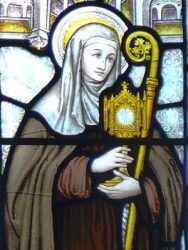
• 23 September, feast of the finding of her body
• 3 October, feast of her first translation, celebrated within the Poor Clares
Clare's father was a count, her mother the countess Blessed Orsolana. Her father died when the girl was very young. After hearing Saint Francis of Assisi preach in the streets, Clare confided to him her desire to live for God, and the two became close friends. On Palm Sunday in 1212, her bishop presented Clare with a palm, which she apparently took as a sign. With her cousin Pacifica, Clare ran away from her mother's palace during the night to enter religious life. She eventually took the veil from Saint Francis at the Church of Our Lady of the Angels in Assisi, Italy.
Clare founded the Order of Poor Ladies (Poor Clares) at San Damiano, and led it for 40 years. Everywhere the Franciscans established themselves throughout Europe, there also went the Poor Clares, depending solely on alms, forced to have complete faith on God to provide through people; this lack of land-based revenues was a new idea at the time. Clare's mother and sisters later joined the order, and there are still thousands of members living lives of silence and prayer.
Clare loved music and well-composed sermons. She was humble, merciful, charming, optimistic, chivalrous, and every day she meditated on the Passion of Jesus. She would get up late at night to tuck in her sisters who'd kicked off their blankets. When she learned of the Franciscan martyrs in Morrocco in 1221, she tried to go there to give her own life for God, but was restrained. Once when her convent was about to be attacked, she displayed the Sacrament in a monstrace at the convent gates, and prayed before it; the attackers left, the house was saved, and the image of her holding a monstrance became one of her emblems. Her patronage of eyes and against their problems may have developed from her name which has overtones from clearness, brightness, brilliance - like healthy eyes.
Toward the end of her life, when she was too ill to attend Mass, an image of the service would display on the wall of her cell; thus her patronage of television. She was ever the close friend and spiritual student of Francis, who apparently led her soul into the light at her death.
16 July 1194 at Assisi, Italy
11 August 1253 of natural causes
26 September 1255 by Pope Alexander IV
• embroiderers, needle workers
• eyes, against eye disease
• for good weather
• gilders, gold workers, goldsmiths
• laundry workers
• telegraphs
• telephones
• television (proclaimed on 14 February 1958 by Pope Pius XII)
• television writers
• Poor Clares
• Assisi, Italy
• Santa Clara Indian Pueblo
• host
• monstrance
• woman with a monstrance in her hand(s)
Saint Clare of Assisi, by Nesta de Robeck (read online / download in EPub format)
The Life and Legend of the Lady Saint Clare, by Brother Francis du Puis (read online / download in EPub format)
Go forth in peace, for you have followed the good road. Go forth without fear, for he who created you has made you holy, has always protected you, and loves you as a mother. Blessed be you, my God, for having created me. - Saint Clare of Assisi
O wondrous blessed clarity of Clare!
In life she shone to a few;
after death she shines on the whole world!
On earth she was a clear light;
Now in heaven she is a brilliant sun.
O how great the vehemence of the
brilliance of this clarity!
On earth this light was indeed kept
within cloistered walls,
yet shed abroad its shining rays;
It was confined within a convent cell,
yet spread itself through the wide world.
- Pope Innocent IV
He, Christ, is the splendor of eternal glory, "the brightness of eternal light, and the mirror without cloud." Behold, I say, the birth of this mirror. Behold Christ's poverty even as he was laid in the manger and wrapped in swaddling clothes. What wondrous humility, what marvelous poverty! The King of angels, the Lord of heaven and earth resting in a manger! Look more deeply into the mirror and meditate on his humility, or simply on his poverty. Behold the many labors and sufferings he endured to redeem the human race. Then, in the depths of this very mirror, ponder his unspeakable love which caused him to suffer on the wood of the cross and to endure the most shameful kind of death. The mirror himself, from his position on the cross, warned passers-by to weigh carefully this act, as he said: "All of you who pass by this way, behold and see if there is any sorrow like mine." Let us answer his cries and lamentations with one voice and one spirit: "I will be mindful and remember, and my soul will be consumed within me." - from a letter to Blessed Agnes of Prague by Saint Clare of Assisi
https://catholicsaints.info/saint-clare-of-assisi/
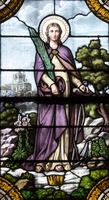
• Filomena, Filumena, Philumena, Philomene
• Thaumaturga of the Nineteenth Century
• Wonder Worker of the Nineteenth Century
Little is known of her life, and the information was have was received by private revelation from her. Martyred at about age 14 in the early days of the Church.
In 1802 the remains of a young woman were found in the catacomb of Saint Priscilla on the Via Salaria, Rome, Italy. It was covered by stones, the symbols on which indicated that the body was a martyr named Saint Philomena. The bones were exhumed, cataloged, and effectively forgotten since there was so little known about the person.
In 1805 Canon Francis de Lucia of Mugnano, Italy was in the Treasury of the Rare Collection of Christian Antiquity (Treasury of Relics) in the Vatican. When he reached the relics of Saint Philomena he was suddenly struck with a spiritual joy, and requested that he be allowed to enshrine them in a chapel in Mugnano. After some disagreements, settled by the cure of Canon Francis following prayers to Philomena, he was allowed to translate the relics to Mugnano. Miracles began to be reported at the shrine including cures of cancer, healing of wounds, and the Miracle of Mugnano in which Venerable Pauline Jaricot was cured a severe heart ailment overnight. Philomena became the only person recognized as a Saint solely on the basis of miraculous intercession as nothing historical was known of her except her name and the evidence of her martyrdom.
• Pope Leo XII granted permission for the erection of altars and churches in her honour
• Pope Gregory XVI authorized her public veneration, and named her patroness of the Living Rosary
• The cure of Pope Blessed Pius IX, while archbishop of Imola, was attributed to Philomena; in 1849, Pius named her patroness of the Children of Mary
• Pope Leo XIII approved the Confraternity of Saint Philomena, and raised it to an Archconfraternity
• Pope Pius X raised the Archconfraternity to a Universal Archconfraternity, and named Saint John Vianney its patron
• Saint John Vianney himself called Philomena the New Light of the Church Militant, and had a strong and well-known devotion to her
Others with known devotion to her include
• Saint Anthony Mary Claret
• Saint Mary Euphrasia Pelletier
• Saint Francis Xavier Cabrini
• Saint John Nepomucene Neumann
• Saint Madeline Sophie Barat
• Saint Peter Chanel
• Saint Peter Julian Eymard
• Blessed Anna Maria Taigi
• Blessed Pauline Jaricot
• relics discovered on 24 May 1802
• relics translated to Mugnano, Italy on 10 August 1805
by Pope Gregory XVI
• against barrenness, infertility, sterility
• against bodily ills
• against mental illness
• against sickness, sick people
• babies, infants, newborns, toddlers
• children, young people, youth
• Children of Mary
• desperate, forgotten, lost or impossible causes
• Living Rosary
• orphans
• poor people
• priests
• prisoners
• students, school children
• test takers
• anchor (an image of one was inscribed on her tomb)
• arrows
• crown
• lily
Life and Miracles of Saint Philomena (read online / download in EPub format)
Saint Philomena, The Wonder-Worker, by Father Paul O’Sullivan, O.P. (read online / download in EPub format)
Nothing is denied to Saint Philomena. - Mary, Mother of God, during an apparition to Mother Mary Louisa of Jesus
To discredit the present decisions and declarations concerning Saint Philomena as not being permanent, stable, valid and effective, necessary of obedience, and in full-effect for all eternity, proceeds from an element that is null and void and without merit or authority. - Pope Saint Pius X, 1912
https://catholicsaints.info/saint-philomena/
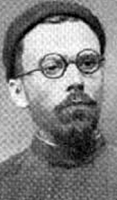
Mauritius, Mauricio
Seventh of eight children born to Jean-Joseph Tornay and Faustina Dossier, and likely named for Saint Maurice of the Theban Legion who had been martyred in the area. He was baptised at 13 days old, made his First Communion at age 7, and during his youth he walked a hour each way each week through the mountain passes to get to church. Raised on a farm, he helped his family work it in his time after school. In his teens, he studied for six years at the school at the Abbey of Saint Maurice where he was an exceptional student with a love of French literature, and where he served as president of his class. Pilgrim to Lourdes, France. Maurice had a special devotion to Saint Thérèse of Lisieux, and would read to class mates from works by Saint Thérèse and Saint Francis de Sales.
Member of the Canons Regular of Saint Augustine, Hospitallers of Saint Nicholas and Grand-St-Bernard of Mont Joux, beginning his novitiate on 25 August 1931 and making his first vows on 8 September 1932. His studies and plans to be a missionary were interrupted for surgery and recovery in 1934 due to a stomach ulcer, but he made his solemn vows in 1935, and in 1936 was sent to the mission in Weixi, Yunnan in southwest China on the border of Tibet. There he spent his initial time studying theology, medicine, dentistry, the local language, and praying about his vocation. Ordained a priest in Hanoi (in modern Vietnam) on 24 April 1938. In the summer of 1938 he was tasked with founding and supervising the Houa-Lo-Pa seminary for local students; he also taught and worked on spiritual formation. He claimed that the largest hurdle to overcome in all this work was his own laziness. When the Japanese invaded the region in 1939, some of the work had to be scaled back, and Father Maurice was forced to beg for food for his seminarians.
In 1945 he was named pastor of the Yerkalo mission in Tibet where Dalai Lama Gun-Akhio ruled. The Lama hated Christian missionaries, helped instigate anti-Christian persecutions, and Maurice withdrew to China in hopes of convincing the Buddhists to reduce the pressure on Tibetan Christians. In addition to ministering to converts and the sick, and praying for a way to resume his mission, Maurice asked the Apostolic Nuncio and Chinese government to intervene with Gun-Akhio, but diplomacy failed. In July 1949 he planned to travel to Lhasa to plead with the Dalai Lama for religious freedom for Christians, but some Tibetan guards ambushed and shot him; the guards later received a cash reward for this work. Martyr.
31 August 1910 in Rosière, Valais, Switzerland
• shot by Tibetan guards on 11 August 1949 in To-Thong, Tibet
• buried in the garden of the Atuntze mission
• re-interrred at the graveyard of the Yerkalo mission in Tibet in 1985
16 May 1993 by Pope John Paul II at Saint Peter's Basilica, Rome, Italy
To fulfill my vocation to leave the world and devote myself entirely to the service of souls to lead them to God, and save myself. - Blessed Maurice's mission statement upon joining the Canons
https://catholicsaints.info/blessed-maurice-tornay/

• Alexander of Comana
• Alexander of Cuma
• Alexander the Carbonaio
• Alessandro....
Well-born, educated, and erudiate 3rd century Greek with philosophical training. Convert to Christianity. To escape his pagan roots and live for God, he left his native area and became a charcoal burner at Comana, Pontus, Asia Minor (in modern Turkey). Noted for being exceptionally ragged and filthy.
When Saint Gregory Thaumaturgus oversaw a council of laymen and religious to pick a bishop for Comana, he told them to ignore outward appearance, and choose the most spiritual person among them. Alexander, dressed in his work rags, and covered in soot and dirt, was dragged forward, apparently as a joke. He tried to play dumb, but when Gregory ordered him to be honest, he admitted his education, his study of the Scriptures, and his life of living as a "fool for Christ." Scrubbed and robed, the council questioned him, recognized his spiritual wisdom, and chose him as their bishop.
Well-loved by his people, Alexander died a martyr in the persecutions of Diocletian.
Greek
burned alive c.275 at Comana (in modern Turkey)
charcoal burners
Men look upon clothes and the face,
But God looks at the soul and the heart.
Glorious Alexander, a charcoal-burner, was,
With the charcoal-burner, the body is blackened
And from soot, which water cleanses,
In the sinner, the heart is darkened
Which only the fire of faith can cleanse
The fire of faith and the cry of repentance.
It is easier to cleanse the skin of a charcoal-burner
Than the blackened heart of a sinner.
Alexander, with humility, covered
In a cave concealed, as a hidden flame
For laughter, to the gullible world, he was.
The world did not see; Gregory saw,
With an acute spirit, the charcoal-burner discerned
And in him, found a saint,
In the dark cave, a beautiful flame,
Beneath the mask of insanity, great wisdom,
Beneath the dirty soot, a pure heart,
A royal soul in decayed rags.
That the light be hidden, the Lord does not permit,
At the appropriate time, the light proclaims,
For the benefit and salvation of men.
All is wonderful, what God judges.
- Hymn of Praise of Saint Alexander, Bishop of Comana, from the Prologue of Ohrid
https://catholicsaints.info/saint-alexander-the-charcoal-burner/

Lifelong layman in the archdiocese of Valencia, Spain, baptized at the age of one day. Member of Youth Catholic Action at age 14; he eventually served as president of the local chapters. An excellent catechist, he established several “catechist centers” where he would teach each Sunday, travelling by foot or bicycle to one after the other throughout the day; he was roundly heckled and abused by people on his way as there was growing anti–Christian sentiment in the area. One night he had to resort to violence to protect his parish priest and spiritual director from a mob; this led to organizing faithful members of Catholic Action to patrol churches and convents, and Carlos himself was only just in time to rescue consecrated hosts from a church that was being looted. He was devoted to daily Mass, a daily morning Rosary, and developed a minstry to the poor. Married to Louisa Tomo Perseguar on 3 November 1934 at the parish church of Santa Maria Ontinyet; they had one daughter. Arrested at dawn on 4 August 1936 in the persecutions of the Spanish Civil War for the crime of being an active Christian. Martyr.
25 December 1907 in Ontinyent, Valencia, Spain
shot on 11 August 1936 in Agullent, Valencia, Spain
11 March 2001 by Pope John Paul II
Viva Christo Rey! (Long live Christ the King!) - dying words of Blessed Carlos
https://catholicsaints.info/blessed-carlos-diaz-gandia/

• Father Teofilo
• Teofilo Fernández de Legaria Goñi
The son of Tomas, a farmer, and Fermina, a school teacher for over 50 years. He began studying at a junior seminary when he was ten years old, and throughout his school years was known as an excellent student. In 1915 he became a novice in the Picpus Fathers at the San Miguel del Monte convent near Miranda, Spain. He was immediately recognized as an gifted teacher.
Ordained a priest on 22 September 1925, and he earned a doctorate in theology. He worked to continue education in Madrid in the face of rising anti–Catholicism in the years leading up to the Spanish Civil War. When the war began, he converted his seminary to a hospital. However, when some Communist militia men arrived with wounded men, they recognized Teofilo as a priest, took him away at gun point, and murdered him soon after. Martyr.
5 July 1898 in Torralba de Río, Navarra, Spain
• shot on 11 August 1936 in El Escorial, Madrid, Spain
• buried at the chapel of Saint Damien of Molokai, parish of the Sacred Hearts, Madrid
13 October 2013 by Pope Francis
https://catholicsaints.info/blessed-benjamin-fernandez-de-legaria-goni/
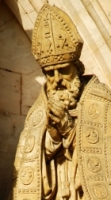
Djèri, Gau, Gery, Gagericus, Gaugerico, Gorik
• 18 November for the exhumation of his relics
• 24 September for the translation of his relics
Son of Gaudentius and Austadiola. Pious youth. Ordained as a deacon when he showed he knew all the Psalms by heart. Priest, ordained by Saint Magnericus of Trier. Bishop of the dioceses of Cambrai and of Arras, Gaul for 39 years beginning c.586. He convinced his people to destroy their old pagan idols; when there were only a few left in private hands, he bought them and destroyed them himself. Tirelessly travelled his territory, and spent largely to ransom prisoners. Attended the Council of Paris in 614.
at Trier, Germany
• c.625 of natural causes
• interred in the church of Saint Medard, Cambrai, France
• some relics in assorted churches in Belgium
mitred bishop without his crosier, right hand lifted in a gesture of benediction and left folded upon his breast
• Braine-le-Comte, Belgium
• Brussels, Belgium
• Cambrai, France, archdiocese of
• Cambrai, France, city of
https://catholicsaints.info/saint-gaugericus/
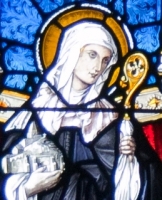
Abaght, Adhracht, Araght, Athracta, Taraghta, Tarahata
Daughter of an Irish noble. Drawn from an early age to a religious vocation, which was opposed by her family. Made her religious vows to Saint Patrick at Coolavin, Ireland. Worked with Patrick for the conversion of Ireland. Anchoress at Drumconnell, County Roscommon. At Killaraght (Cill Attracta) on Lough Gara she founded a hospice that still existed as late as 1539. Founded several churches and convents in County Galway and County Sligo. The convents were known for their care of the sick, and were traditionally built at crossroads so they would available to more travellers. Miracle worker, and noted healer. A healing well with her name survives at Clogher, Monasteraden; it has a reputation for especial powers against warts and rickets. Incredibly popular in her own day and in the Middle Ages when popular (i.e., fantastic) biographies of her circulated.
5th century in County Sligo, Ireland
6th century in Ireland of natural causes
• Achonry, Ireland, city of
• Achonry, Ireland, diocese of
• Men of Lugna
https://catholicsaints.info/saint-attracta-of-killaraght/

A lifelong layman, Rafael was married to Maria Adelaid Ruiz Glens in 1916; the couple were parents to four daughters. He worked as postmaster in Ontinyent, Valencia, Spain, and served as catechist and youth teacher by night at his parish. Member of the Catholic Legion, Catholic Action, School of Christ, Association of the Sacred Heart of Jesus, and was a Franciscan Tertiary.
Arrested for his faith by Communist militia during the Spanish Civil War, he was imprisoned and abused in hopes of getting him to renounce Catholicism; it didn’t work. He was shot on a roadside with Blessed Carlos Diaz and abandoned, but Rafael survived. Friends hid him at a local Capuchin convent, and later died of his wounds. He forgave his killers and insisted that there be no retribution, revenge or feud between his family and theirs. Martyr.
14 June 1890 in Ontinyent, Valencia, Spain
shot 11 August 1936 in Agullent, Valencia, Spain
11 March 2001 by Pope John Paul II
https://catholicsaints.info/blessed-rafael-alonso-gutierrez/

Roman noble, the beautiful daughter of Saint Gabinus, and niece of Pope Caius, living in the early part of Diocletian's reign when the last large-scale persecutions were building steam. Having made a private vow of virginity, and not wanting to be part of a family that murdered her family in faith, she refused to marry Maximian, Diocletian's son-in-law. Her piety was such that she converted Claudius and Maximus, relatives and the messengers sent to bring her to Maximian. In revenge, she was exposed as a Christian, beaten, and martyred.
No reliable Acta of her life have survived, but her story has, and she is commemorated in many ancient Martyrologies. A Roman parish and church has borne her name since the fifth century. In 1969 she was dropped from the universal calender of saints, but her memorial is still celebrated in Saint Susanna's basilica in Rome.
• beheaded in 295 in her father's house at Rome, Italy
• buried by Diocletian's wife, a closet Christian
• the house became the original church with her name
https://catholicsaints.info/saint-susanna-of-rome/
Stephen Rouse
• 29 October as one of the Martyrs of Douai
• 22 November as one of the Martyrs of England, Scotland and Wales
• 1 December as one of the Martyrs of Oxford University
Studied at Oriel College, Oxford University. Anglican vicar of Saint Mary the Virgin, Oxford, England. Convert to Catholicism. Studied at the Douai College in Rheims, France. Ordained a priest in 1582 at Soissons, France. He then returned to England to minister to covert Catholics during a period of persecution. He was soon arrested for the crime of priesthood, and exiled. When he returned to England he was arrested again, convicted again, and executed. Martyr.
c.1555 in Oxfordshire, England
hanged, drawn and quartered on 3 April 1587 in Gloucester, Gloucestershire, England
22 November 1987 by Pope John Paul II
https://catholicsaints.info/blessed-stephen-rowsham/

Equizio
Spiritual student of Saint Benedict of Nursia. Benedictine monk. Worked to spread monasticism throughout Italy, bringing many scholars and future saints to the religious life and the Benedictine Order. Abbot of a house in Valeria, Italy. Noted preacher Pope Saint Gregory the Great refers to Equitius in his Dialogues.
between 480 and 490 in the area of Valeria Suburbicaria (present-day L'Aquila-Rieti-Tivoli), Abruzzi, Italy
• c.570 at the monastery of San Lorenzo di Pizzoli of natural causes
• relics translated to Aquila, Italy
Aquila, Italy
holding a monastery, emblematic of the houses founded through his work
https://catholicsaints.info/saint-equitius/
Marcia
Born to the nobility and raised in a Christian family. Nun at an early age at an abbey founded by Saint Caesarius of Arles. Abbess in Arles, Provence (in modern France) for almost 60 years. Known for her deep and meditative prayer life, asceticism, and her endless fight to defend the abbey from political pressure. At one point, because of her defiance of civil authorities, she was imprisoned; King Clotaire II recognized her innocence and ordered her released.
551 in Vaison (in modern Séguret, France)
• 11 August 632
• buried at her abbey in Arles, France
https://catholicsaints.info/saint-rusticola-of-arles/
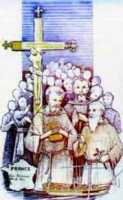
Father Thomas
Dominican priest. Imprisoned on a ship in the harbor of Rochefort, France and left to die during the anti-Catholic persecutions of the French Revolution. One of the Martyrs of the Hulks of Rochefort.
21 April 1752 in Katzenthal, Haut-Rhin, France
11 August 1794 aboard the prison ship Deux-Associés, in Rochefort, Charente-Maritime, France
1 October 1995 by Pope John Paul II
https://catholicsaints.info/blessed-jean-georges-rehm/
• 29 October as one of the Martyrs of Douai
• 22 November as one of the Martyrs of England, Scotland, and Wales
Priest in the apostolic vicariate of England. Martyred in the persecutions of Queen Elizabeth I.
c.1552 in Lancashire, England
11 August 1586 in Gloucester, Gloucestershire, England
22 November 1987 by Pope John Paul II
https://catholicsaints.info/blessed-john-sandys/
22 November as one of the Martyrs of England, Scotland, and Wales
Layman in the apostolic vicariate of England during a period of persecutions of Catholics. Martyr.
in Gloucester, Gloucestershire, England
December 1588 in Gloucester, Gloucestershire, England
22 November 1987 by Pope John Paul II
https://catholicsaints.info/blessed-william-lampley/

Tiburcio, Tiburzio
Son of Saint Chromatius the Prefect. Martyr. Pope Saint Damasus wrote about him.
• beheaded c.286 in Rome, Italy
• entombed in the Ad duas lauros cemetery at the three mile marker on the Via Lavicana of Rome
https://catholicsaints.info/saint-tiburtius-of-rome/

Taurino
Evangelist in Milan, Italy. First bishop of Evreux, Normandy (in modern France) c.385. Fought against the pagan customs of the region. Miracle worker.
c.350
c.412
Evreux, France
https://catholicsaints.info/saint-taurinus-of-evreux/
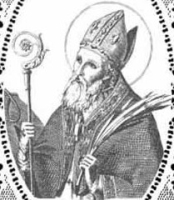
Rufino
First century bishop of Assisi, Umbria, Italy. Martyr.
1st century
• diocese of Assisi-Nocera Umbra-Gualdo Tadino, Italy
• Assisi, Italy
• Umbria, Italy
https://catholicsaints.info/saint-rufinus-of-assisi/
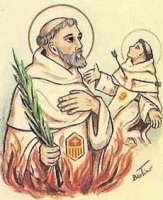
Mercedarian friar. He and several brother Mercedarians were sent to Africa to ransom Christians held in slavery by Muslims. They were captured by pirates, imprisoned, and eventually martyred.
burned at the stake in 1499
https://catholicsaints.info/blessed-theobald-of-england/
Degna
Young woman in 4th-century Todi, Italy who made a private vow of consecration to God. During the persecutions of Diocletian she retreated to the nearby mountains to live as an anchoress.
https://catholicsaints.info/saint-digna-of-todi/
Bishop of Benevento, Italy.
• c.340
• relics in the church of Saint Mary in Benevento, Italy
https://catholicsaints.info/saint-cassian-of-benevento/
Third-century imperial Roman prefect. Brought to the faith by Saint Tranquillinus. Father of Saint Tiburtius of Rome.
https://catholicsaints.info/saint-chromatius-the-prefect/
Early bishop. Martyred with several Christian companions whose names have not come down to us.
in Italy
https://catholicsaints.info/saint-rufinus-of-marsi/
Thousands of people were murdered in the anti-Catholic persecutions of the Spanish Civil War from 1934 to 1939. I have pages on each of them, but in most cases I have only found very minimal information. They are available on the CatholicSaints.Info site through these links:
• Blessed Antoni Casany Villarrasa
• Blessed Armando Óscar Valdés
• Blessed Miquel Domingo Cendra
• Blessed Ramon Rosell Laboria
• Elian of Philadelpha
• Robaldo Rambaudi
CatholicSaints.Info Portable Edition